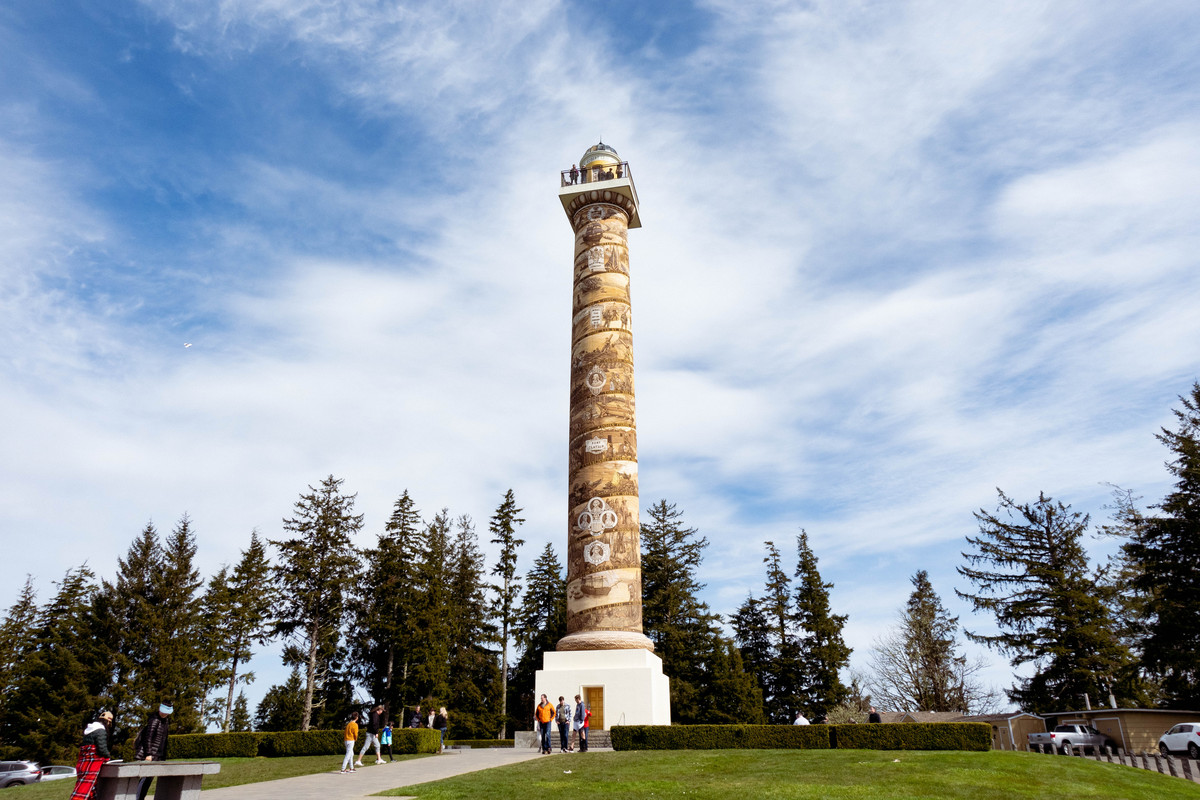Built on the highest point overlooking the mouth of the Columbia, and decorated with an enormous, hand-crafted mural, the Astoria Column isn’t your average scenic viewpoint. Visitors brave enough to scale the steps of the 125-foot structure in the port town of Astoria, Oregon will be rewarded with a 360° view of the mouth of the Columbia River and the surrounding landscape below.
From the top of the monument, sightseers are not only allowed to fly pinewood airplanes off of the Column, but are actively encouraged to do so—in the gift shop at the base of the tower, the Astoria Column staff sell pinewood gliders for a dollar apiece.
Each year, the Column draws in over 300,000 visitors from all over the world, who visit the monument for both the views and history it has to offer.
“I think part of what brings people to Astoria…is all the history,” said Easton Barendse, a staff member at the Column’s visitor center. “I’ve had a lot of people who just wander up here, and they’re like, ‘wow, this is cool, I’m glad we followed the little signs all the way up here.’”
In many ways the Column attempts to act as a physical icon for the history of Astoria, which played a key role in the fur trade that built much of Oregon’s economy in the 19th century. The mural that covers the Column’s walls is a larger-than-life illustration of the town’s past, as seen by people of the time.
Although the Column’s mural illustrates the region’s history, the monument itself has a history of its own—one that is almost as complex as the story of the town that it commemorates.
The Astoria Column began life in the roaring ‘20s as the brainchild of Ralph Budd, a railroad tycoon known for completing the Northern Pacific Railway, which stretched from St. Louis to Oregon. Not one to let his accomplishments go uncelebrated, Budd built a series of six monuments along the route of his railroad line, each one tied to the history of the area in which it was built.
“When the railroads started coming out west, they built little monuments along the way,” Barendse said. “When they got here, they wanted something big to commemorate all their hard work, so they were like ‘this is the highest point in town, let’s build something up there.’”
For the Astoria monument, which represented the end of the line for his railroad empire, Budd spared no expense, and commissioned Italian artist Attilio Pusterla to cover the entire 125-foot-tall exterior of the tower with murals illustrating the region’s history.
Rather than just have the murals drawn in paint, Budd took the added step of commissioning them in sgraffito, a Mediterranean artform that layers multiple colors of plaster on top of each other before carving them away to reveal the colors beneath, creating elaborate designs of various colors.
Even for Budd, the idea was ambitious—a mural done of the Column’s size in sgraffito had never been done outside of Italy, and when completed it would earn the distinction of being the largest sgraffito mural in the world.
Local Astorians of the time seemed to be enthusiastically supportive of the idea, and in a summary of the proposed artwork written by the Astoria Evening Budget, the style was described as “an ancient one which has come down in Europe from classical times as one of the five methods of heroic sculpture.”
Budd himself appeared to reflect the Astoria Evening Budget’s enthusiasm for telling a story of mythic proportions. In a Dec. 10, 1929 memo to the Portland Press Club, Budd stated that the Column was “one of a series of monuments located along the Great Northern Railway,” created to “commemorate outstanding events in the progress of pioneers in conquering the western wilderness.”
Budd’s commitment to celebrating the pioneers who supposedly conquered the wilderness underscored the importance of understanding the tower’s artwork and conception for what it was—an attempt to generate a mythology of westward expansion.
Budd, who appeared to see himself as a kind of latter-day pioneer in his own right, valorized the actions of the prospectors and explorers who came to the land in search of economic resources to exploit. In another section of his memo to the Portland Press Club, Budd stated that he and his colleagues hoped to tell the story of the region, “beginning with its discovery and ending with the arrival of the railway train.”
Budd’s choice to begin the mural’s narrative with the region’s discovery by settlers quietly ignores the reality of the Indigenous groups that had already been living there—some of them for at least 10,000 years prior to Meriwether Lewis and William Clark’s arrival in the area.
The ethnocentric attitude of the Column’s creators is subtly reflected in the artwork, as the panel representing the area prior to European discovery is totally absent of Indigenous people, featuring only plants and the occasional animal.
In some ways, the ethnocentrism of the Column can be used as an important reminder that the region we live in still praises the actions of opportunistic pioneers and fur-trapping profiteers.
Besides being a 125-foot-tall history lesson, the Column serves as many other things as well. For many tourists, the tower’s position as the highest vantage point in the region offers a chance for childish fun, as people compete to see who can fly gliders the furthest from the observation deck.
Barendse, who sells the gliders at the Column’s gift shop, explained the history behind the tradition.
“For a long time people used to throw whatever they wanted from the top,” Barendse said. “It became dangerous…so back in the late ‘80s or ‘90s, we started selling the gliders in here…it’s something safe and fun to throw off the top.”
The idea caught on, and dozens of wooden planes scattered around the parking lot of the tower testify to the tradition’s popularity.
Besides its role as a vantage point and wooden plane launchpoint, the Astoria Column has lent itself as a picnic spot, a wedding proposal destination and a place where local parents could take their kids to burn off energy running up the tower’s steep flights of stairs.
Whatever the reason for visiting, the trip to the Astoria Column is worth a journey up to the far northwest corner of Oregon—provided that we remain mindful of the monument’s complicated history.






